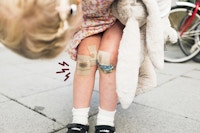Eczema
Eczema is a collective term for irritated or itchy skin diseases. Eczema can be chronic (long-term) and / or acute.
Acute eczema is characterized by red, swollen and itchy skin and fluid-filled blisters can be seen. Chronic eczema is typically itchy and when itched, and when frequently scratched areas will form with thickened skin that cracks easily. The most common forms of eczema are: atopic eczema, diaper eczema, contact eczema, seborrheic dermatitis.
-
Symptoms
Atopic eczema
Atopic eczema is chronic (long-lasting), recurrent and characterized by itching and skin ulcers. The disease causes a reduced skin barrier, drier skin, and is often hereditary. Atopic eczema typically debuts early in life and most people are diagnosed before the age of six. Many people experience improvement in the summer and deterioration in the winter. The cause of atopic eczema is unknown. Other family members often have atopic diseases such as asthma, eczema or hay fever. In 20-30% there are allergies and this can in some people worsen the eczema in periods.Contact dermatitis
Contact dermatitis is characterized by red, swollen skin with small and large blisters and exuding sores. Eczema occurs on areas that come in direct contact with substances to which the skin reacts. If the contact dermatitis has lasted a long time, the skin typically becomes dry and cracked. Severe itching is common. The eczema is limited to the part of the skin that has been in contact with what you have reacted to, but eventually it can spread to other areas of the body.Seborrheic eczema
Seborrheic eczema causes scaly chronic eczema and affects skin areas where there are a lot of sebaceous glands. Typical scalp, ears, eyebrows, nostrils, in areas with beard growth in men, on the eyelid rim and in skin folds. In infants, typically scalp, skin folds and diaper region. The eczema is symmetrical and the scales are yellow and oily or dry and white. Under the dandruff, the skin is red and irritated. Itching is very common. Seborrheic eczema is probably due to the skin's reaction to naturally occurring skin fungi. Treatment that kills the fungus improves eczema.Diaper rash
Diaper rash is an inflammation of the skin in the diaper region. Such inflammation is usually a reaction to contact with irritants. An infection can also occur in the irritated skin. Red, patchy changes with a smooth, glossy surface are typical symptoms. Later it can be sore. Common rash due to diaper use is most visible where the skin is in contact with the diaper. If the rash spreads into the skin folds as well, this is usually a sign that the rash has become inflamed with fungi or bacteria. Half of all infants have problems with the skin in the diaper region at times, and 5% show marked inflammation in the skin. -
What can I do myself?
The most important thing in the treatment of eczema is good hygiene, proper cream as well as ointment treatment, to avoid dry skin, chlorination and reduce the use of foods that aggravate or trigger the eczema.
Atopic eczema
Moisture treatment is very important and always after bath and shower, which should otherwise be reduced. Soap dries out the skin and should not be used on skin with eczema changes. Soap with a pH below 5.5 is generally best and oil baths should be used frequently. Otherwise avoid stiff and tight clothes, coarse wool, chlorine water, brightly colored clothes, perfume etc.Seborrheic eczema
Shampoo with fungicide is used against seborrheic dermatitis of the scalp, while creams with antifungal effect are used on the face and other places on the body. The treatment is lifelong. There is usually a need for a period of frequent treatment for two to four weeks before switching to maintenance treatment around once a week. Men who let the beard grow can reduce the problems by trimming the beard so that the shampoo has an effect on the skin.Diaper rash
When the use of a nappy is necessary, the nappies must be changed frequently so that the skin is kept dry and the stool must be removed immediately. High pH soap should be avoided. Where cleaning with water is not sufficient, use a synthetic or oily detergent. After cleansing, cover the skin with water-repellent ointment / barrier cream, possibly with zinc ointment. Zinc inhibits the production of ammonia and promotes healing of the wound in addition to the ointment having a barrier function. -
What can Eyr help with?
- Assess eczema and type
- Start treatment if necessary
- Write a prescription or renew regular medications
- Follow up with ongoing consultations
- Adjust and re-evaluate treatment plan
- Refer to a dermatologist if needed
